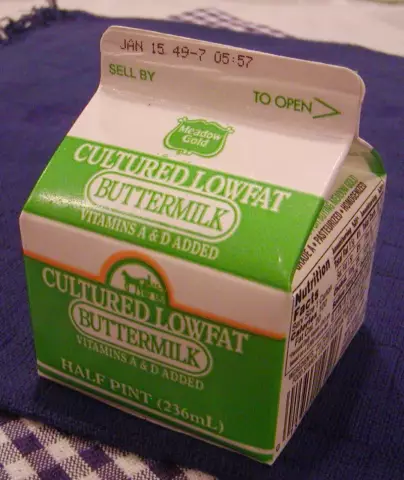- Author Rachel Wainwright [email protected].
- Public 2023-12-15 07:39.
- Last modified 2025-11-02 20:14.
Buttermilk
Buttermilk is a low-fat dairy product obtained as a result of butter production and is a by-product in the technological process. Buttermilk is rich in biologically active components, while it has a low calorie content due to its low fat content.
Eating buttermilk

Buttermilk is eaten as an independent product, and is also widely used in baking, serves as a raw material for the manufacture of fermented milk products. In addition, buttermilk is used in animal husbandry as a cheap feed option for young animals.
Sour milk drinks made from buttermilk have a pronounced sour milk taste, a viscous homogeneous consistency and a white color.
Condensed buttermilk is also available with or without added sugar. Condensed buttermilk is characterized by a three-fold increase in protein concentration compared to fresh buttermilk, making it a valuable source of protein. If we compare condensed buttermilk with condensed milk, then an important difference between condensed buttermilk will be its much lower fat content, which significantly reduces the calorie content of the product.
Powdered buttermilk is widely used in the culinary and food industry and is not widely used in retail chains. The exception is dry dessert, which is a mixture of condensed buttermilk with berry juices, dried using a special technology. The product resembles a marshmallow and is ready to eat.
Buttermilk making
On average, making 1 kg of butter produces about 1.5 kg of buttermilk. As an independent product, buttermilk exists in three types, which differ in the proportions of biologically significant components. Belonging to one type or another is determined by the technological features of the manufacture of oil.
Buttermilk is isolated as a result of:
- Periodic whipping of cream;
- Constant whipping of cream;
- Making butter by converting cream.
Buttermilk is also distinguished separately from sour cream and sweet butter. It is possible to determine from which oil the buttermilk is obtained by its taste and smell. Unlike sweet buttermilk, which has no off-flavors or aftertaste, sour buttermilk has the characteristic sour creamy taste and aroma of this butter.

Fresh buttermilk with various flavors or without them is sold as an independent product, and can be used in the food industry to normalize milk, produce cottage cheese and cheese, release dry and condensed buttermilk, as well as to isolate biologically significant components.
The benefits of buttermilk
There are fermented drinks on the market that fully reveal the full benefits of buttermilk, while not causing complications associated with partial lactose intolerance. But in the event that a person completely lacks the enzyme lactose that breaks down milk sugar, it is better not to use fresh buttermilk. Fermented buttermilk-based drinks can be a substitute.
The high protein, mineral and vitamin content, combined with the low calorie content, determines the health benefits of buttermilk. Buttermilk is rich in iron, potassium, calcium, phosphorus, sodium and magnesium, as well as vitamins E, PP, D and A. Regular consumption of buttermilk improves metabolism and the composition of the intestinal microflora.
The calorie content of fresh buttermilk is approximately 33 kcal per 100 g of product. The calorie content of fermented milk and condensed buttermilk largely depends on the additional components added to the product. Look for the calorie information of a particular dairy product on the label.
Found a mistake in the text? Select it and press Ctrl + Enter.






